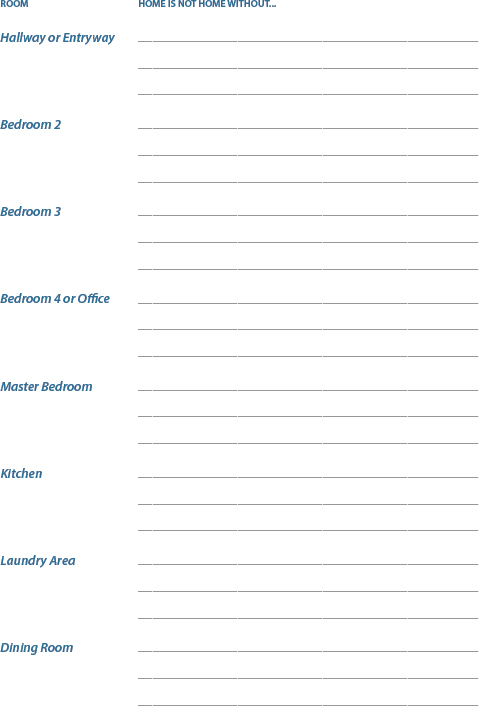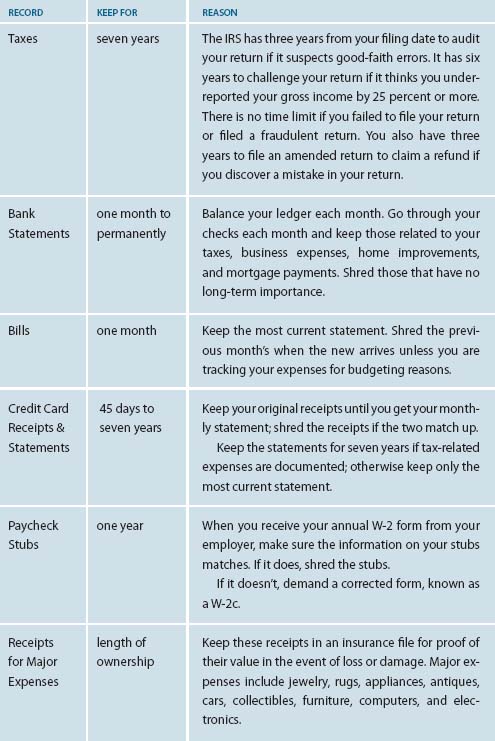
Appendix
THE APPENDIX INCLUDES THE QUESTIONNAIRES AND CHARTS I’ve used throughout the book. These forms also include plenty of blank space so you can record your answers directly in this book. I’ve included a few key resources; most of yours will be local, coming from trusted family and friends. The “Keep Less” questions are worth bookmarking because you’ll come back to them often; you may want to make a photocopy that you can carry with you to help you make a better decision when you are contemplating an impulse buy. You’ll also find room to journal about how you would like to spend your time so you can organize your schedule to support your goals, interests, and obligations.
My Goal Definition Worksheet
My goal is:


I’ll know I’ve achieved my goal when:


When I achieve my goal, it will mean … (What will I be able to do?)


This goal reflects the following important value(s) for me:


What metaphor resonates with me? As I begin my fresh start with this goal, I expect things to look and feel like this:


And when I achieve this goal, the metaphor I identify with will be:


Not achieving this goal will have these negative consequences:


The attitudes and internal clutter holding me back that I need to shift or let go
of are:


Which external clutter challenges will be difficult? Which will be easy?


I have the following external support systems available to help me now:


I will support myself while reaching this goal by … (self-care: sleep, exercise, rewards, etc.)


Developed by Susan Fay West and Kathryn May, Life by Intention
Clearing the Clouds of Confusion Exercise
Transitions can leave your thoughts in a fog of confusion. Things have changed, and you may feel like aspects of your life are out of control. This exercise will help you identify the aspects of your life that you are satisfied with and the aspects of your life that you want to improve. You will need a pen and a stack of index cards or sticky notes.
Consider the components of your life. Examples could be:
| Family/Children | Self-Care/Exercise | Social/Friends | ||
| Family/Partner | Self-Care/Medical | Social/Romantic | ||
| Family/Parents | Job/Career | Social/Clubs | ||
| Living Situation | Finances/Short-Term | Hobbies/Creativity | ||
| Self-Care/Rest | Finances/Long-Term | Spirituality | ||
| Self-Care/Diet | Finances/Retirement Plan |
1. Write one component per index card. Make as many as you need and add components specific to your life.
2. Arrange the index cards so the components are placed in order from what you are most satisfied to least satisfied with. You could rank them A, B, C, etc., or give each a ranking between one and ten. Even if you are dissatisfied with everything, some things will be better than others. Rank them honestly. You may find you are more satisfied than you thought.
3. Focus on the bottom three components. Decide why you are dissatisfied. Then decide whether you’d like to identify steps you can take to change this or if you’d like to make some of the strong areas even stronger. Then work your way around the list until you are satisfied with every aspect of your life.
Suggested Reading List
The E-Myth Revisited: Why Most Small Businesses Don’t Work and What to Do About It by Michael E. Gerber. Published by HarperCollins.
I Could Do Anything If I Only Knew What it Was: How to Discover What You Really Want and How to Get It by Barbara Sher and Barbara Smith. Published by Dell.
Organizing for the Creative Person: Right-Brain Styles for Conquering Clutter, Mastering Time, and Reaching Your Goals by Dorothy Lehmkuhl and Dolores Cotter Lamping. Published by Three Rivers Press.
Simple Abundance by Sarah Ban Breathnach. Published by Warner Books.
What’s Next: Women Redefining Their Dreams in the Prime of Life by Rena Pederson. Published by Cahners Business Information, Inc.
Room Tour Questions
What do you see? _____________________________________
What do people comment on when they arrive? __________
What kind of energy do you feel in this spot? _________
What’s in place? Out of place? __________________
How would you like this space to be?___________________
What activities go on here?____________________________
What activities used to occur here but don’t anymore (but the stuff is still located here)? And what activities would you like to have happen here but don’t today because of clutter or space or other considerations?


What frustrates you about this area? __________________
Do you enjoy the color scheme?_________________________
What systems are important to have here and are they working for you today? (Sometimes it is helpful to answer this with a 1–10 scale, 10 being perfect. Usually, some parts of the system are working; it’s not the whole system that’s failed you.)


Keep Less Questions
Put a copy of this list in your purse or wallet and consult it when you consider purchasing an item and bringing it into your home.
How would I use it or where would I wear it?

Do I already have one?

Is this how I want to spend my money and/or time?

Can I borrow this item from someone I know or swap with a friend or family member for this item?

Does it fit my new life?

How important is this compared to the space, money, and time it will consume? What’s really important to me now?

Where will I put it? Where will its home be within my house?

HOME IS NOT HOME WITHOUT…


Decluttering Your Calendar
What would you rather be doing with your time? This question identifies your values, which will help you make clearer choices when you have scheduling conflicts.
Paint the full picture. Identify all of the things you must do and all of the things you want to do. How much time will it all take? What will you need to give up?
Identify what and who saps your energy. Decline or delegate tasks you dread.
Wear your hats well. Draw an organizational chart of your work life and then of your home life. Which roles are you best at? Keep these. Consider removing or mitigating the others, things you don’t do well or put off, from your schedule.
Chunk it down. What’s the smallest step you can take so you can get started on the task right away? It’s easier to fit in small steps, and you can make steady progress.
Anchor yourself. David Allen pioneered the idea of a weekly review for the workplace in his book Getting Things Done. The weekly review idea is also useful with your personal life. Toward the end of the week, set aside thirty minutes to review your life for the upcoming week.
Keep track of time. Use a clock or timer to track how long it takes you to accomplish your everyday tasks. Record these times electronically or on paper. Then use this information to accurately understand how time passes as well as to budget your time. Always give yourself a fifteen-minute cushion to account for interruptions or delays.
Instead of one more thing, do one less thing. I used to be the one running into meetings right on time (sometimes late) or getting to a friend’s house late for dinner. Why? Because I was doing “just one more thing” before I’d leave the house or office. Now I do one less thing, and guess what, the task I left undone is still waiting for me when I return.
Identify How You Would Like to Spend Your Time
These are the key questions to ask yourself as you decide what to do and how to spend your time in your next chapter. Take time to journal about each of these questions.
What do you value? What is important now?





Where are you doing the best in your life or living the best version of you? What’s working well?





Which facet of your life would you like to improve?




What do you currently know about what you want next, no matter how small you may think it sounds?






What do you know about your vision or about your ideas for your next chapter? Write it, paint it, say it aloud—whatever works to keep it alive.






What is holding you back internally?






What do you need to let go of? What makes it difficult to let go? What do you need or what questions can you ask yourself to make a no-regrets decision and move on?






What is important to keep with you going forward? What is now permanently part of your being, your core, your essence?






What has this life event taught you about yourself?






How can that new information help you create your next chapter?






How have you created something from nothing (or very little) in the past? What principles, ideas, or actions from that experience can you apply to this new experience?






What are the major accomplishments in your life? How did you approach and achieve them?






What is one goal you can limit yourself to for now? It’s important to start and finish one goal and then move on to another. If you start several at once, it’s difficult to sustain momentum because your first success takes longer. A success, no matter how small, feeds you.






How will you know when you have achieved that one goal? How will you realize it, feel it, or see it? What does it look like or feel like when you’ve achieved the goal?






What are the smallest steps you can take to begin chipping away at your goal?






How Long to Keep Records


Source: “How Long to Keep Financial Records,” Bankrate.com, www.bankrate.com/finance/personal-finance/how-long-to-keep-financial-records.aspx (Accessed February 8, 2011).
Resources
Professional Organizers
• www.napo.net, official website of the National Association of Professional Organizers. Certified Professional Organizers carry the CPO® after their names.
• www.challengingdisorganization.org, official website for the Institute for Challenging Disorganization. Look for the specialty certificate and/or certification by ICD (CPO-CD®).
• www.coachapproachfororganizers.com, official website for the Organizer Coach. Professional Organizers who have learned and are using coaching skills in their organizing client work have better results. Their clients become clearer about what they want from their lives and from the organizing work. They partner with the Organizer Coach in the creation of new structures and systems. Because clients are more engaged in the process, the transfer of skills and commitment to maintenance is greater. Follow-up and accountability are built into the relationship.
• www.certifiedprofessionalorganizers.org. The Board of Certification for Professional Organizers (BCPO®) Certification is a voluntary, industry-led effort that benefits the members of the organizing profession as well as the public. It recognizes professionals who have met specific minimum standards and have proven through examination and client interaction that they possess the body of knowledge and experience required for certification.
Timers and Counters to Track How Long You Organize
Inventory Software
• Quicken www.quicken.intuit.com/personal-finance-software/home-inventory-manager.jsp
• Know Your Stuff® inventory software, from the Insurance Information Institute. www.ezasset.appspot.com/viewOnlyNoLogin.do?page=front_kys&brand=iii
Resources for Donating
• Valuing your donations: www.goodwill.org/get-involved/donate/taxes-and-your-donation